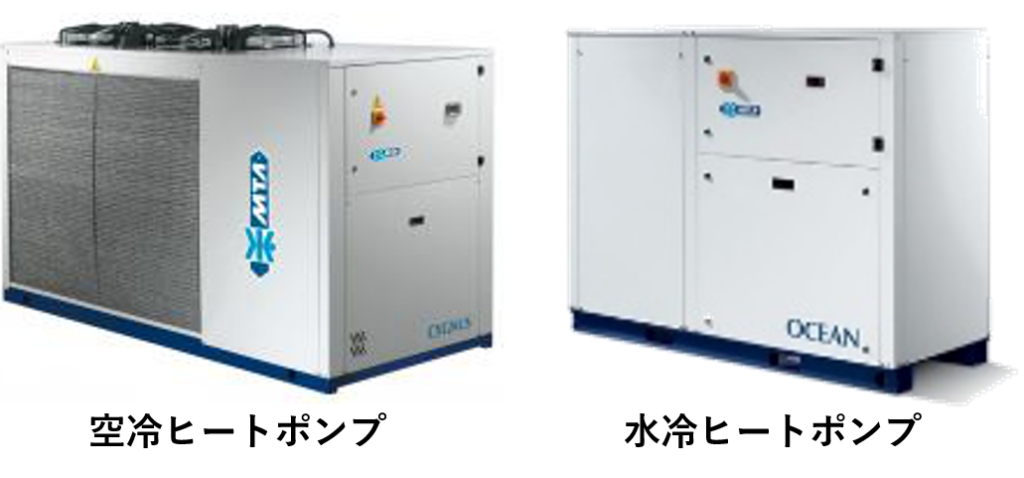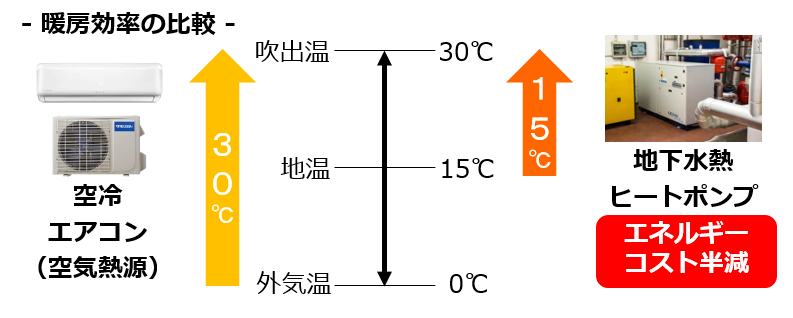What is a heat pump? The basics and how to save energy

A heat pump is a "heat pump"
We are often asked, "What is a heat pump?" At first glance, a heat pump may seem like a very complicated mechanism, but what it does is actually quite simple. In this column, rather than explaining its complicated structure, we will explain the basic role of a heat pump and its energy-saving elements.
As the name suggests, a heat pump is a pump that pumps heat. First, let's consider a typical pump.
Water naturally flows from higher to lower places, but it cannot flow the other way. Therefore, to move water from a lower place to a higher place, it is necessary to use a pump to pump it up.
In fact, the same is true for heat pumps. Heat naturally moves from high temperature areas to low temperature areas. The reverse does not happen naturally. A heat pump is a device that pumps heat from low temperature areas to high temperature areas.

Heat pumps are used in a variety of places.
Heat pumps are used in many familiar places. A typical example is air conditioners. When heating, they pump heat from the outside into the room to warm it up. In summer, they do the opposite, pumping heat from inside the room to the outside to cool it down.
Refrigerators are also part of the heat pump family. They pump the heat from inside the refrigerator out.
EcoCute is also a heat pump. It draws heat from the outside air and transfers it to water to make hot water.
In either application, the ability to supply a lot of heat with a small amount of electricity is a major advantage.

Heat pump structure
Here is a simple explanation of the structure of a heat pump. Like water pumps, heat pumps are generally powered by electricity. (There are also heat pumps that use fuel, such as GHP.)
A heat pump is filled with a refrigerant gas, which is compressed by a compressor and decompressed by an expansion valve in a repeated cycle. When the gas is compressed and decompressed, the temperature also changes accordingly. Using this property, a heat pump transfers heat by using the gas.
As a result, it is possible to supply more heat than is required to power the compressor.
The coefficient of performance (COP) is an index that indicates how many kW of heat a heat pump can supply when 1 kW of electricity (fuel) is input to the heat pump. Although it depends on the conditions, the COP of a heat pump is often 3 or more, making it a highly efficient technology.

Heat pump structure (from the Heat Pump and Thermal Storage Center website)
Heat pumps always require a "heat source"
There is an important principle here. A heat pump needs a heat source. Heat does not just come out of thin air.
For a heat pump to supply heat, it must receive heat from somewhere. When it receives heat, the heat source cools. When the heat pump heats, the heat source cools. When the heat pump cools, the heat source warms. How to secure this heat source is a very important factor in making heat pumps energy efficient.
Ideally, the amount of heat should be as large as possible and the temperatures of the heat source and destination should be close to each other.
When considering the energy saving of heat pumps, the first thing to consider is the "heat source." Let's consider the ideal heat source here.
Most heat pumps use either air or liquid as their heat source, the former being called "air-cooled" heat pumps and the latter "water-cooled" heat pumps.
It is better to retain as much heat as possible, but when comparing air and liquid, liquid has an overwhelming amount of heat retention per volume. Under the same temperature conditions, a water-cooled heat pump that uses water as a heat source is more efficient.
The next thing to consider is the temperature difference between the heat source and the heat destination. A water pump will use less electricity to pump water to a lower height. Here too, heat pumps are the same as water pumps.
The closer the temperature of the heat source is to the supply destination, the less electricity is consumed. However, if we think of an air conditioner, for example, we turn on the heater because it is cold outside, and we use the air conditioner to increase the temperature difference between inside and outside.
There is a contradiction there.

The value of geothermal, groundwater heat and heat recovery heat pumps
The value of geothermal/groundwater heat/heat recovery heat pumps lies first in the fact that they are compact and highly efficient because they use water or liquid as their heat source, and above all, that the heat source temperature is close to the supply temperature.
When groundwater is used for air conditioning, the temperature is much closer to the indoor outlet temperature in summer than when using outside air as a heat source, and in winter, since it is warmer than the outside air, it is close to the indoor outlet temperature. This is the reason why energy savings are achieved.
When there is a high demand for heating, high efficiency and reduced waste can be achieved by using waste hot water, which still contains sufficient heat, as a heat source.

When planning a heat pump, it is important to properly design the heat source environment!
Heat source design is extremely important when introducing heat pumps, not just water-cooled heat pumps that use groundwater or exhaust heat. In order to get the most out of heat pumps, it is necessary to proactively incorporate the concept of heat source design.
